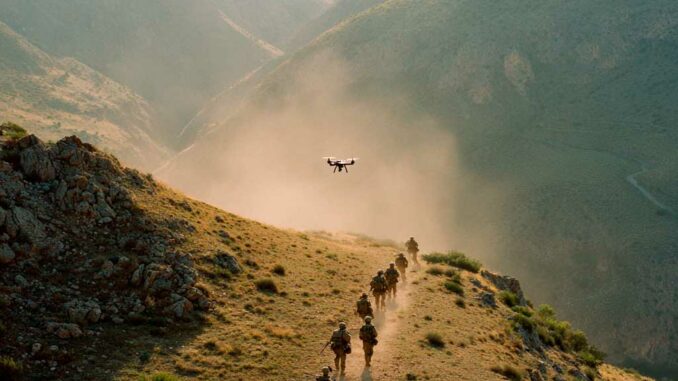
The Pentagon is reclassifying light drones as ammunition, accelerating their production, autonomous use, and role in modern warfare.
The US Department of Defense has radically changed its policy on the use of military drones, particularly small models (Groups 1 and 2). These aircraft will now be treated as consumables, like grenades, rather than durable aerial platforms. The reclassification is intended to facilitate their production, purchase, and use by field units, including at lower levels of the chain of command. The new doctrine aims to strengthen the US drone industry, rapidly integrate artificial intelligence into their use, and make small armed drones a common tool for every squad, particularly in preparation for a large-scale conflict in the Indo-Pacific. Inspired by practices observed in Ukraine, this strategy aims for massive and rapid adoption, breaking with the bureaucratic slowness of the past. By 2026, each unit could have several inexpensive and expendable drones at its disposal.
A doctrinal break: small drones treated as ammunition
The core of the new US strategy is based on the reclassification of light drones as consumer goods. In concrete terms, drones in Group 1 (less than 9 kg, maximum speed 185 km/h, altitude up to 370 meters) and Group 2 (between 9.5 kg and 25 kg, up to 460 km/h and 1,065 meters altitude) are now considered single-use tools, in the same way as grenades or artillery ammunition.
This approach breaks with the previous logic, where each drone was treated as a micro-aircraft that had to meet heavy standards, such as NATO’s STANAG 4586. By removing these constraints, the Pentagon hopes to facilitate the acquisition, maintenance, and replacement of these systems in the field. This also reduces costs by allowing for simplified designs without the need for standardized interoperability.
The implications for military logistics are significant. The storage, distribution, and use of these drones will now fall under the traditional weapons supply chain. Ultimately, a squad could have several single-use drones at its disposal, prepared in advance, much like standard ammunition, including for reconnaissance, targeted strike, or light electronic warfare missions.
Strategic decentralization of operational decisions
Another major change is that the Pentagon now grants broad autonomy to O-6 level commanders, i.e., colonels in the Army and Air Force, and captains in the Navy. These officers will be able to authorize the purchase, testing, and use of light drones without prior approval from higher ranks.
This decentralization aims to reduce administrative delays, which have often been criticized in recent conflicts, and to respond quickly to battlefield needs. It also brings manufacturers closer to combat forces through an accelerated co-design model that includes local solutions and 3D printing in the field.
A commander will therefore be able to purchase a drone produced in a military workshop, provided that its components are certified on the Blue List, which lists suppliers deemed reliable for unmanned systems. This dynamic encourages internal innovation and rapid adaptation, similar to what the Ukrainians are already doing in their civil-military workshops.
At the same time, officers are authorized to test non-lethal autonomous drones in controlled environments, promoting rapid experimentation with prototypes adapted to specific terrains (urban areas, forests, mountains, coastlines).

A prioritized national industry to support mass production
Faced with dependence on foreign components, particularly from China, US policy is based on a clear strategy: produce domestically, and on a large scale. The Department of Defense plans to certify hundreds of US-designed drone models for military procurement and to support manufacturers through a coordinated flow of private capital.
The executive branch is relying on the presidential executive order “Unleashing American Drone Dominance,” signed in June 2025, which aims to strengthen the entire domestic industry for both military and civilian uses. The stated goal is to compete with Ukrainian manufacturers, which are expected to produce between 2.5 and 3 million drones this year, or more than 200,000 units per month.
The United States, for its part, has not yet reached these production levels. In May 2025, the US military issued a call for tenders for the delivery of 10,000 light drones within a year. While this volume remains modest compared to Ukrainian capabilities, it marks a turning point in procurement doctrine.
This ramp-up will require major adjustments to the military supply chain, particularly in terms of batteries, optics, electronic chips, and lightweight chassis. The origin of components will also need to be controlled, as certain markets are largely dominated by unsecured Asian suppliers.
A transformed operational doctrine integrated into training
The integration of drones into military training is becoming a priority. The document requires that, by the end of 2026, every major exercise include drone warfare scenarios, including swarm attacks, live fire, and combat simulations in degraded areas.
To this end, the Pentagon intends to lift current restrictions on military airspace, in coordination with the Federal Aviation Administration (FAA). New training grounds will be dedicated to training, with at least three national centers equipped with a variety of areas, including maritime areas, accessible to all branches at no additional cost to the joint services.
At the same time, experimental training programs will be created by September 2025 within each branch, with the mission of accelerating the widespread use of small drones within all units, particularly those under the Indo-Pacific Command. This also includes specialized program offices responsible for focusing resources on small UAS, without spreading them across other priorities.
This transformation is accompanied by a clear objective: every combat squad will be equipped with lightweight, expendable drones by the end of 2026, with priority given to strategic areas such as the Asia-Pacific region. This standardization echoes practices observed in Ukraine, where the use of drones has become as common as individual weapons.
Toward tactical warfare amplified by low-cost technology
One of the most notable effects of this policy is the evolution of the tactical role of the combatant, particularly within the Marine Corps. Soldiers, once limited to the range of their weapons or grenades, can now strike 15 or 20 kilometers away by guiding a small drone equipped with a light military payload.
These drones, sometimes referred to as guided grenades, can fly over an area for several minutes, transmit live images, and strike a designated target with precision. Their unit cost is estimated at less than €4,500, much lower than that of a conventional tactical missile, while offering formidable accuracy.
This use transforms the principles of tactical superiority and shifts the lethal capabilities of soldiers toward individual technological projection. Far from large, complex systems, this approach emphasizes flexibility, stealth, and embedded intelligence.
But this logic also poses ethical and technical challenges: human control, system autonomy, cybersecurity, and compliance with conventions. The proliferation of inexpensive drones does not eliminate the risks associated with jamming, loss of control, or uncontrolled proliferation.
War Wings Daily is an independant magazine.